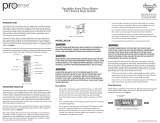Page is loading ...

SERIES FS FLOWMETER with FLOW LIMIT SWITCH
Specifications - Installation and Operating Instructions
Bulletin F-41-FS
T
he Series FS Flowmeter with Flow Limit Switch combines the proven
t
echnology of direct reading, piston type, variable area flowmeter with a
hermetically sealed, solid state switching module. This combination aids the
machine designer/troubleshooter by providing instantaneous flow rate indication
coupled with an electronic signal module to automatically alert the operator if any
incorrect flow rate is detected.
MECHANICAL INSTALLATION
CAUTION: Do not over tighten the threads on the plastic body. Overtightening the
NPT threads may cause fracturing of the plastic flowmeter body. The flowmeter is
constructed of polysulfone and remains stable to 210˚F (99˚C). Do not expose the
flowmeter to open flames or excessive heat. The meter may melt, crack, or distort.
Some pipe dope formulas will react adversely with polysulfone. Use pipe thread
sealant tape if a sealing material is necessary.
The Series FS Flowmeter can be mounted in any plane of orientation. Horizontal
or vertical mounting does not effect flowmeter accuracy. The inlet and outlet of the
flowmeter should be aligned, particularly when high temperature, high pressure, or
combination of both may be encountered. Install the flowmeter in the direction of
the indicating arrow on the scale. The Series FS FLowmeter does not require
lengths of straight pipe at the inlet, or outlet, to stabilize flow through the meter.
These meters can tolerate particles that normally will jam other flow controls. If
large amounts of particulates are encountered, a 200 mesh or 74 micron filter is
recommended.
A separate four conductor female connector is supplied with the limit switch
assembly. The connector must be disassembled to solder wires onto it. See Figure
1. The connector has four solder lugs labeled; 1,2,3, and 4. Terminals 3 and 4 are
not used. It should be noted before reassembly, which wire is connected to which
solder plug. Color coding or labeling the wires is advised. Secure wire to solder
lugs and determine the orientation of the connector body. See Figure 2. After
choosing orientation A, B, or C, snap the connector back together, pull excess
wires out of strain relief, and tighten strain nut. Plug into electric housing and
secure with screw.
DWYER INSTRUMENTS, INC.
Phone: 219/879-8000 www.dwyer-inst.com
S
PECIFICATIONS
S
ervice: Compatible liquids.
Wetted Materials: Polysulfone body, Barium Ferrite, Stainless Steel spring and
retaining rings.
Temperature Limits: 158°F (70°C).
Pressure Limits: 325 psi (22.4 bar).
Accuracy: ±5% full scale.
Repeatability: 1.0%.
Set Point: Adjustable 0 to 100% FS.
Relay Load: 1 A @ 30 VDC; 0.5 A @ 125 VAC (resistive).
Supply Voltage: 115 VAC, ±10%.
Current Consumption: 25 mA max.
Process Connections: 1˝ male NPT Polysulfone or 3/4˝ male NPT brass.
Flow Scale: Calibrated at 1.0 specific gravity @ 70°F (21°C).
Weight:
1˝ male NPT Polysulfone; 0.55 lb (0.25 kg); 3/4˝ male NPT brass: 0.90 lb
(0.41 kg)
.
Agency Approvals: CE.
2
2
4
4
6
6
8
8
1010
55
1010
1515
2020
2525
3030
3535
GPMGPM
LPMLPM
FLOW DIRECTIONFLOW DIRECTION
PAT NO 4389901PAT NO 4389901
1.0 SP. GR.1.0 SP. GR.
DWYER INSTRUMENTS, INC. MICHIGAN CITY IN.DWYER INSTRUMENTS, INC. MICHIGAN CITY IN.
FSXXXXXFSXXXXX
3/4 NPT Brass Inlet
1-1/2 Hex
B
oth Ends
Ø
1-5/16
[33.65]
3
/4 NPT Brass Outlet
1
-3/8
[
35.0]
5
-1/4
[133.35] Polysulfone Body
8-1/4
[209.55]
1-47/64
[43.94]
1-7/8
[47.63]
SERIES FS
F
LOW (GPM)
15.0
12.5
1
0.0
7.5
5.0
2.5
0
.0
0
.0
2
.5
5.0
7
.5 10.0
12.5
1
5.0
17.5
2
0.0
22.5 25.0
27.5
PRESSURE DIFFERENTIAL (PSID)
4 GPM
7 GPM
1
6
G
P
M
2
8
G
P
M
BODY
STRAIN RELIEF NUT
SOLDER LUG
POLARITY PIN
2
1
FIGURE 1

E
LECTRICAL INSTALLATION
The module can only switch loads that consume between 2.5 and 90 watts, or have
5000 Ω to 150 Ω impedence respectively. If the load draws less than 2.5 watts, a
0.47 uF loading capacitor is required. This capacitor will increase the power
consumption and ensure complete conduction over 15-20% of full scale, above or
b
elow the flow rate setpoint. For loads greater than 90 watts, see Figure 4 and 5.
Figure 4 demonstrates a SPDT relay with a 115 VAC coil integrated with the limit
switch module. This combination allows switching of loads up to the rating on the
relay contacts.
DWYER INSTRUMENTS, INC.
Phone: 219/879-8000 www.dwyer-inst.com
©Copyright 2014 Dwyer Instruments, Inc. Printed in U.S.A. 9/14 FR# RV-440909-00 Rev. 2
T
he flow switch can be integrated with latching type relays. See Figure 5. The
m
odule will turn the relay “on” as flow exceeds or falls below the flow rate setpoint.
The relay will remain activated until the reset button is depressed.
OPERATION
The limit switch module is designed to turn on or off a variety of different 115 VAC
loads such as solenoid valves, warning lights, and AC relay coils. 1) Loosen the
cap screw on the flow limit switch. 2) Adjust the assembly so the retaining band
centers approximately at the desired flow alert position. 3) Retighten cap screw
securely.
MAINTENANCE
Periodic check of connections is recommended. The Series FS is not field
serviceable and should be returned if repair is needed (field repair should not be
attempted and may void warranty). Be sure to include a brief description of the
problem plus any relevant application notes. Contact customer service to receive
a return goods authorization number before shipping.
INLET OF FLOWMETER
ELECTRONIC HOUSING
POLARITY PIN
C
B
A
F
IGURE 2
L
OAD
2
1
FLOW
MODULE
100.0
0,1
>200V
.47
µ
F
µF
F
OR USE WITH INDUCTIVE LOADS
C
AP MUST BE RATED >200V
ac LINE
ac LINE
FIGURE 3
DPT
RELAY
COIL
2
1
R
1
FLOW
MODULE
R
1
RELAY CONTACT
LOAD
ac LINE
ac LINE
FIGURE 4
DPDT
RELAY
COIL
2
1
FLOW
MODULE
NC RESET
BUTTON
L
OAD
RELAY CONTACT
R1
R
1
R
ELAY CONTACT
R1
ac LINE
ac LINE
FIGURE 5
/


